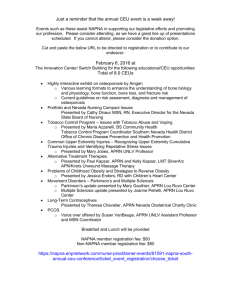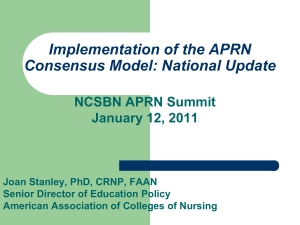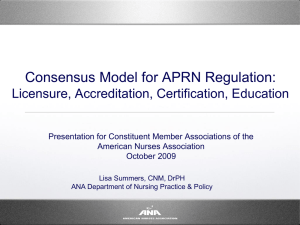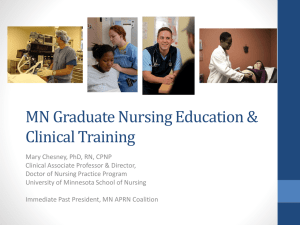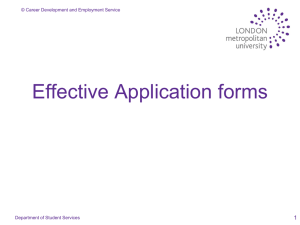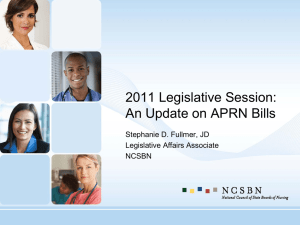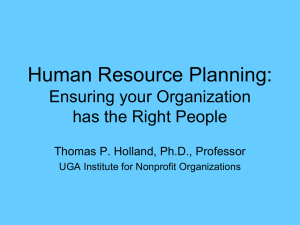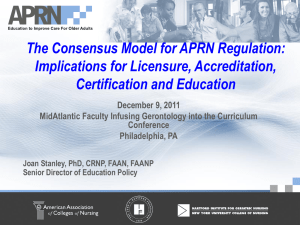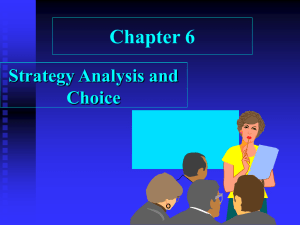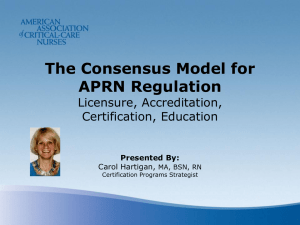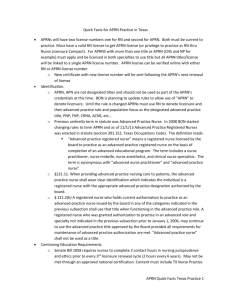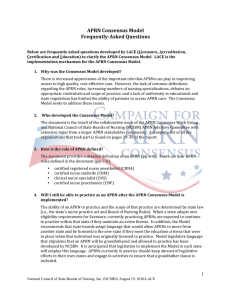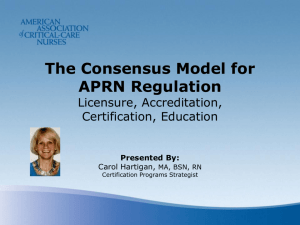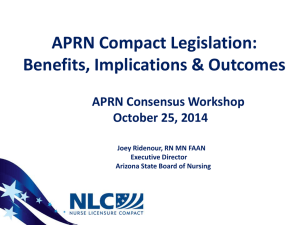Core Competencies in Nursing Credentialing and Certification
advertisement
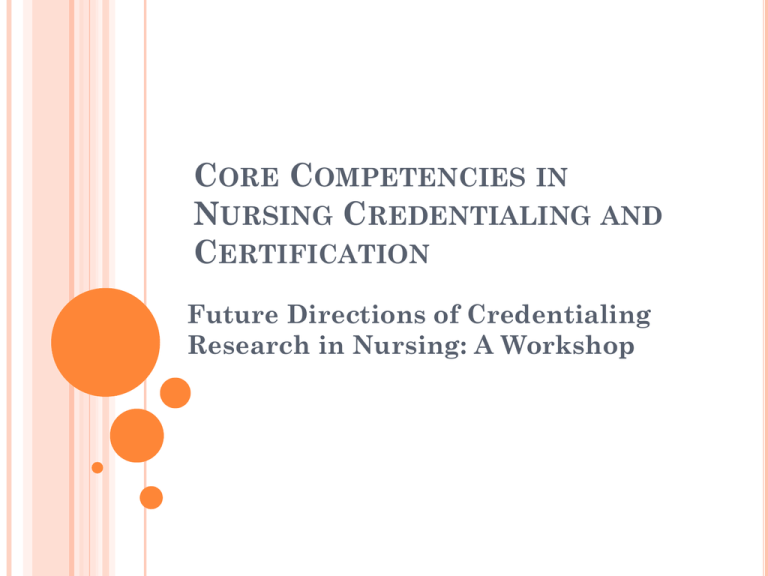
CORE COMPETENCIES IN NURSING CREDENTIALING AND CERTIFICATION Future Directions of Credentialing Research in Nursing: A Workshop DISCLOSURES Laurie M. Lauzon Clabo, PhD, RN Dean, School of Nursing MGH Institute of Health Professions Chair, American Association of Colleges of Nursing (AACN) Task Force on Advanced Practice Registered Nurses (APRN) Clinical Education Work-in-progress; not yet finalized or approved by AACN Board “THE AACN BOARD OF DIRECTORS CHARGES THE TASK FORCE WITH THE DEVELOPMENT OF A WHITE PAPER THAT RE-ENVISIONS CLINICAL TRAINING FOR ADVANCED PRACTICE REGISTERED NURSES (APRNS).” To meet the charge the task force should: 1. 2. 3. Describe the current state of APRN clinical training, challenges, and regulatory requirements. Describe the current state of APRN clinical training, challenges, and regulatory requirements. Consider competency assessment as an emerging and potential element of a re-envisioned approach to APRN clinical training. TO MEET THE CHARGE THE TASK FORCE SHOULD: 4. Develop a set of recommendations for restructured or re-envisioned clinical training, including alternative models for APRN clinical training that: o maximize clinical resources; o consider current and potential financial implications; o provide opportunities to prepare APRNs with the full graduate, role and population-focused competencies; and o highlight opportunities and innovations for interprofessional learning and practice. CURRENT CHALLENGES IN APRN CLINICAL TRAINING Increased demand for APRN services Many programs report being at capacity, with clinical training (along with faculty shortages) cited as a major constriction in the pipeline > 14,600 qualified applications not accepted for graduate programs in 2012 (AACN, 2013) Competition and scarce resources for clinical training sites and preceptors CURRENT STATE OF APRN CLINICAL TRAINING Mounting regulatory issues for in-state and distancelearning students None, inadequate or unstandardized preceptor training Pressure to compensate preceptors Variable student competence when entering clinical training Productivity impact on preceptors Competition for APRN learning experiences, particularly in some areas of practice and geographic regions CORE COMPETENCIES AS A FOUNDATION FOR APRN EDUCATION AND PRACTICE: A THREE DECADE JOURNEY Core Competencies for Nurse Midwifery (1978, 2011) Domains and Core Competencies for Nurse Practitioner Practice (1990, 2011) Statement on Clinical Nurse Specialist Practice and Education (1998, 2004) Scope of Nurse Anesthesia Practice (1980, 2013) COMPETENCIES, LICENSURE AND CERTIFICATION Competencies Measures of competencies Identified by Professional Organizations (e.g. oncology, palliative care, CV) Specialty Certification* Specialty CNP, CRNA, CNM, CNS in the Population context Population Foci Role APRN Core Courses: Patho/physiology, Pharmacology, Health/Physical Assessment Licensure: based on education and certification** APRN * Certification for specialty may include exam, portfolio, peer review, etc. ** Certification for licensure will be psychometrically sound and legally defensible examination be an accredited certifying program, Diagram 2: Relationship Among Educational Competencies, Licensure, & Certification in the Role/Population Foci and Education and Credentialing in a Specialty ONE MODEL: NURSE PRACTITIONER REDESIGN Giddens, J., Lauzon Clabo, L. M., Gonce-Morton, P. Jeffries, P., McQuade-Jones, B., & Ryan, S. (2014) CURRENT STATE: No finite set of nationally recognized, consensus-based common/core competencies for APRNs Emerging national discussion regarding the reliance on “clinical hours” requirements No evidence that clinical hour requirements serve as an effective proxy for NONPF core competencies (Halas et al., 2012) While a competency framework for APRN practice is described as desirable, APRN professional organizations are moving in unique trajectories that are exclusive and unique to each particular role CORE AND ROLE-SPECIFIC COMPETENCIES: A MILESTONES APPROACH Nurse Practitioner Clinical Nurse Specialist Core/Common Nurse Midwife Nurse Anesthetist Preclinical Experiences Clinical Education Graduation Continuing Professional Development RECOMMENDATIONS IN CONSIDERATION APRN TASK FORCE Identify common APRN core competencies across role and population focus Identify milestones for the APRN core competencies from pre-clinical experience to graduation Develop standardized assessment tool to be used by preceptors and/or faculty based on the common core APRN competencies. BY RECOMMENDATIONS FOR STUDY 1. 2. 3. 4. Identification of essential competencies along multiple dimensions (educational preparation, role, population focus, continuing professional development) Development of robust/efficient strategies for assessment Explore the relationship between competencies and patient outcomes especially in light of the unit-based nature of nursing practice in many settings What, if any, relationships exist between individual achievement of competence and group/team/interprofessional performance?
